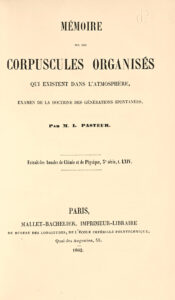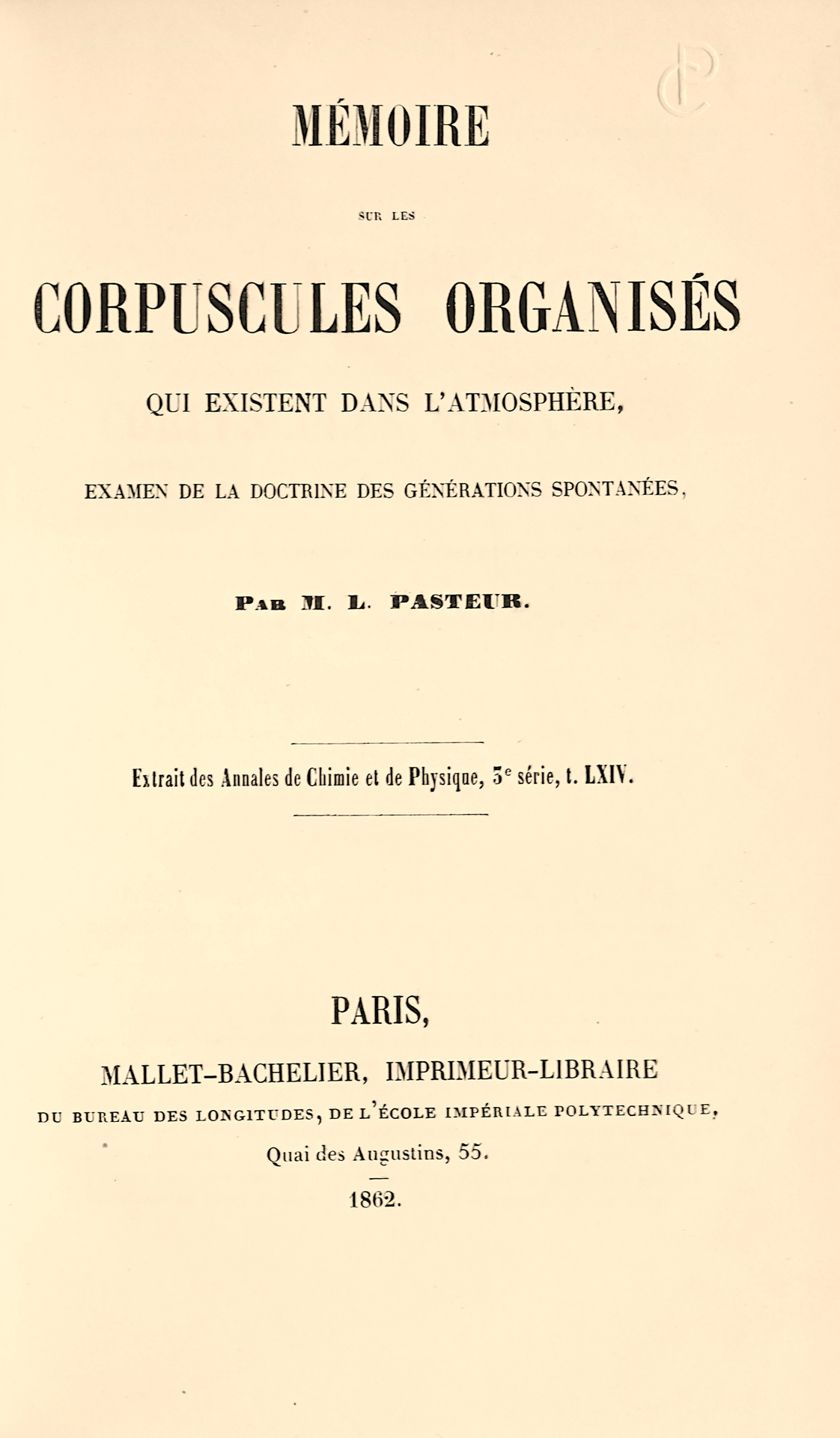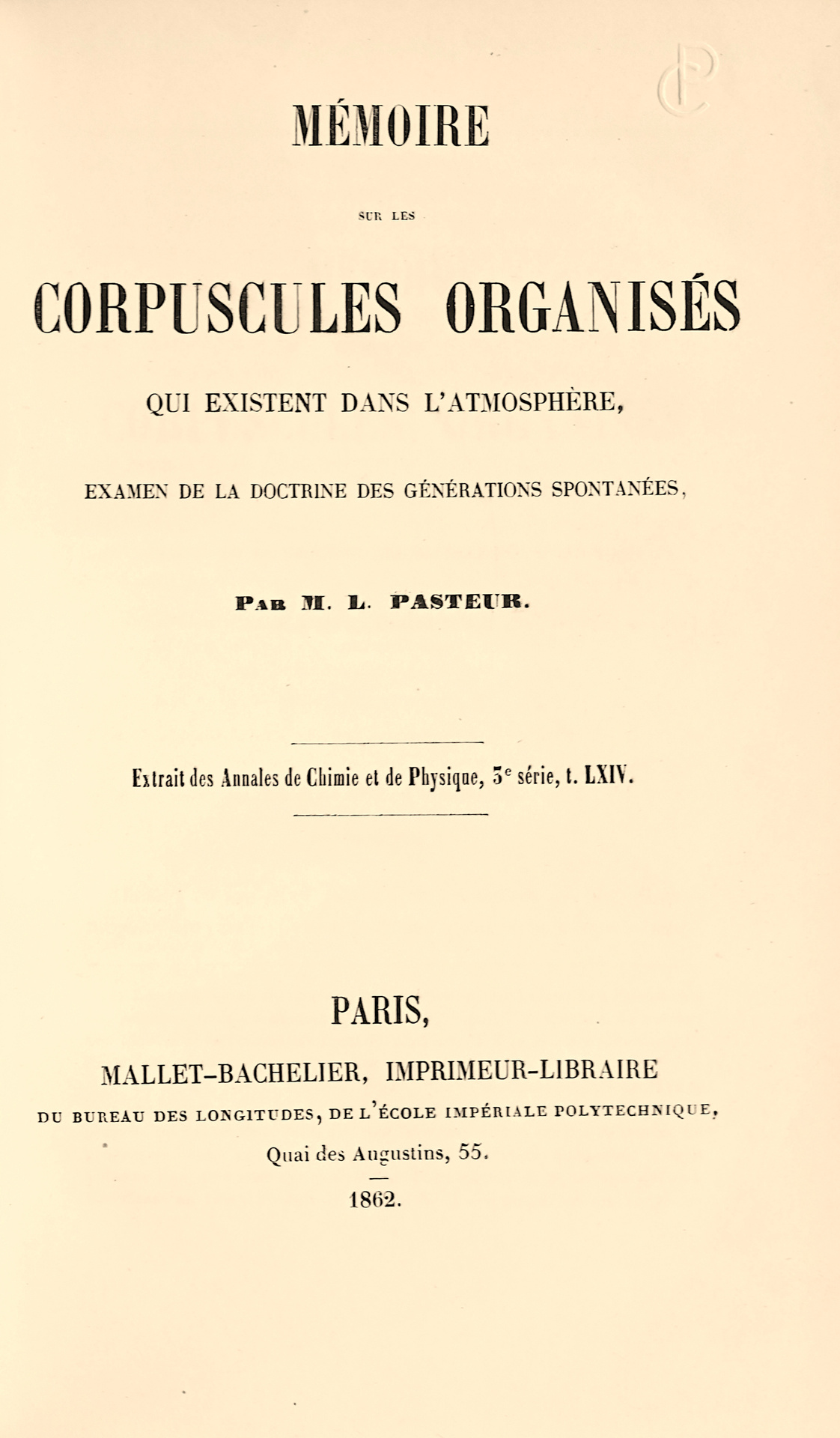Paris, Mallet-Bachelier, 1862.
8vo (215 x 130 mm), pp. 110, with two large folding plates. Contemporary red Jansenist morocco, ribbed spine, inner gilt border, edges gilt. Contemporary binding.
First edition. Very rare offprint of Pasteur’s major work on fermentation proving it is due to minute living organisms (microbes) and demonstrating how pasteurization can prevent it.
It puts an end to the long-running dispute over the theory of spontaneous generation showing that “if these minute organisms are excluded or killed, fermentation does not occur” (PMM).
It is also a landmark in the beginning of microbiology as it allows isolating and culturing cells in a sterile environment.
“The longest and most important of Pasteur’s papers on spontaneous generation, describing the series of classic experiments with bent-necked and sealed flasks by which he proved conclusively that fermentation and putrefaction are not the products of spontaneous generation, but result from contamination by airborne micro-organisms. Pasteur’s experiments also mark the beginning of microbiology since, by showing how to sterilize a liquid and keep it sterile, he opened up the possibility of culturing and studying a single micro-organism in the absence of any others. Pasteur’s paper was first printed in Vol. 16 of the Annales des sciences naturelles, Zoologie, 4th series (1861), but no offprints were made from this journal printing. The present offprint, printed in a small edition, was made from the Annales de chimie et de physique, 3rd series (1862), in which Pasteur’s paper was reprinted a few months after its first appearance” (Norman). Pasteur was led to his studies on spontaneous generation by his experiments on fermentation. “In 1860 he had completed a series of careful but simple ‘Experiments relative to so-called Spontaneous Generation’ … When his conclusions were called into question by Pouchet, who claimed to have repeated his experiments with totally dissimilar results, Pasteur reported in 1861, in ‘Notes on the Organic Corpuscles existing in the Atmosphere,’ further experiments which demonstrated beyond dispute that fermentation is caused by the actions of minute living organisms, and that if these are excluded or killed fermentation does not occur. This enabled him to explain to brewers and vintners the cause and prevention of sourness in their products. The heating process that he recommended was the earliest form of ‘pasteurization’” (PMM).
“Almost from the beginning of his work on fermentation and despite attempts by Biot and Dumas to dissuade him, Pasteur became embroiled in the controversial issue of spontaneous generation. Although advanced in several more or less sophisticated versions, the doctrine of spontaneous generation rests at bottom on the notion that living organisms can arise independently of any immediate living parent, whether form inorganic substances (abiogenesis) or from organic debris (heterogenesis). In his classic paper of 1861, ‘Mémoire sur les corpuscules organisés qui existent dans l’atmosphère,’ Pasteur included a fairly substantial historical introduction, which seems greatly to have influenced subsequent histories of the debate. To account for the modern rise of the doctrine—following its apparent destruction in the seventeenth century by Francesco Redi’s experiments on the generation of insects—Pasteur emphasized the influence of the microscope. By revealing a teeming world of hitherto unseen living organisms of dubious or unknown parentage, the microscope gave the doctrine a new lease on life and led to a celebrated eighteenth-century dispute between Spallanzani and Needham. Spallanzani seemed largely to carry the day by showing that infusions boiled for forty-five minutes in closed vessels (to destroy any organisms they might already contain) thereafter remained free of alteration and microbial life. But his technique was open to the objection that the air in his sealed flasks might have been altered in such a way as to render spontaneous generation impossible. In the early nineteenth century this objection took special force from Gay-Lussac’s study of the role of oxygen in fermentation and putrefaction. Having found that oxygen was absent from substances preserved by Appert’s canning process, and that grapes crushed under mercury in a bell jar fermented only upon the introduction of air, Gay-Lussac concluded that oxygen was essential to the onset of fermentation and putrefaction (and hence to the appearance of any microorganisms associated with these alterations).
“As Pasteur emphasized, Gay-Lussac’s experiments made it imperative to remove any doubts about the possible alteration of air in Spallanzani’s flasks. Toward this end Theodor Schwann made ‘a great step forward’ in 1837 by showing that boiled meat infusions could be preserved from alteration in flasks in which the air was continually renewed, provided only that the added air had been heated or ‘calcined’ before entering the flasks. Schwann’s experiment extended that of Franz Schulze, who in 1836 had achieved similar results by drawing the added air through potassium hydroxide and sulfuric acid; it also helped to set the stage for the work of Heinrich Schroder and Theodor von Dusch, who in the 1850’s exposed alterable substances to ordinary air filtered through cotton. By these means Schwann, Schulze, schroder, and Dusch prevented putrefaction, fermentation, and microbial life in many alterable substances—including meat infusions, beer, must, starch paste, and the constituents of milk taken separately—and tended to suppose that they had done so by eliminating airborne germs. But in the case of other substances—notably milk, egg yolk, and dry meat—their experiments often failed and helped to sustain the view that something like spontaneous generation could occur.
“Moreover, Pasteur insisted, even those experiments which seemed to contradict spontaneous generation did so only in the sense of showing that an unknown something in atmospheric air was essential to life in organic infusions. This unknown principle seemed often to be eliminated by heat, cotton, or certain chemical reagents; but insofar as Schwann and others tended to suppose that atmospheric germs had thus been killed or eliminated, they ‘had no more proofs for their opinion,’ wrote Pasteur, ‘than those who believed that [the unknown principle] might be a gas, fluid, noxious effluvia, etc., and who consequently were inclined to believe in spontaneous generation.’ There, according to Pasteur, the issue lay when Felix Pouchet launched his attempt to establish the doctrine of spontaneous generation on the basis of irrefutable experiments. Pouchet, a respected naturalist from Rouen and a corresponding member of the Académie des Sciences, published in 1859 his long and controversial Heterogène ou traité de la génération spontanée, which created a sensation in France and probably stimulated the Académie des Sciences to institute the Alhumbert Prize in 1860 for the best ‘attempt, by well conducted experiments, to throw new light on the question of so-called spontaneous generations.’
“Pasteur won this competition with his ‘Memoire sur les corpuscles…’ By ignoring a wide range of other factors that helped to discredit spontaneous generation (notably studies of cell division and the debate, by then resolved, over the origin of parasitic worms, it magnified the importance of his own contributions and nearly all subsequent accounts have followed suit. At the end of his historical introduction, Pasteur traced his interest in spontaneous generation to his work on fermentation, and particularly to his recognition that the ferments were living organisms:
‘Then, I said to myself, one of two things must be true. The true ferments being living organisms, if they are produced by the contact of albuminous materials with oxygen alone, considered merely as oxygen, then they are spontaneously generated. But if these living ferments are not of spontaneous origin, then it is not just the oxygen as such that intervenes in their production—the gas acts as a stimulant to a germ carried with it or already existing in the nitrogenous or fermentable materials. At this point, to which my study of fermentation brought me, I was thus obliged to form an opinion on the question of spontaneous generation. I thought I might find here a powerful support for my ideas on those fermentations which are properly called fermentations.’
“As this passage suggests, it is perhaps artificial to separate Pasteur’s study of spontaneous generation from his work on fermentation, especially since some of his adversaries contended that microorganisms could appear as a result of fermentation rather than as its cause. The question of the origin of the ferments was therefore crucial, and Pasteur’s concern with it is apparent from his earliest paper on fermentation.
“In 1858, in his initial paper of fermentation, Pasteur wrote that the lactic ferment ‘originates spontaneously, with as much facility as brewer’s yeast, whenever conditions are favorable,’ but immediately emphasized in a footnote that he used the word ‘spontaneously’ merely to ‘describe the fact, leaving entirely aside any judgment on the question of spontaneous generation.’ In February 1859 he addressed the issue somewhat more directly, asserting that in his experiments the lactic ferment always came ‘uniquely by way of the atmospheric air.’ If he boiled his medium and then removed it from all contact with air or exposed it only to previously calcined air, no microbial life or fermentation of any kind appeared. ‘On this point,’ he wrote, ‘the question of spontaneous generation has made an advance.’
“Beginning in February 1860, Pasteur presented to the Académie des Sciences a series of notes focusing specifically on spontaneous generation. In the first and most important of these papers, he began by examining the solid particles of the air, which he collected by aspirating atmospheric air through a tube plugged with guncotton. When this guncotton was dissolved in a sedimentation tube containing an alcohol-ether mixture, the solid particles trapped by it settled at the bottom. Although this method killed any germs or microorganisms in the trapped particles, microscopic examination always revealed a variable number of corpuscles, the form and structure of which closely resembled those of living organisms. But were these ‘organized corpuscles’ in fact the ‘fecund germs’ of the microorganisms which appeared in alterable media exposed to the air? In search of an answer, Pasteur employed three distinct methods. With the first, involving the use of a pneumatic trough filled with mercury, he obtained somewhat dubious or inconsistent results and abandoned it in favor of a second method, which he characterized as ‘unassailable and decisive.’ In a flask of about 300 cubic centimeters, he placed 100 to 150 cubic centimeters of sugared yeast water, which he boiled for a few minutes. After the flask had cooled, he filled it with calcined air (by means of a neck connected to a red-hot platinum tube) and then sealed it in a flame. The liquid in such a flask, deposited in a stove at 28–32° C., could remain there indefinitely without alteration.
“Having thus far only repeated the experiments of Schwann and others. Pasteur now introduced an important modification. After a month to six weeks he removed the flask from the stove and connected it to an elaborate apparatus so arranged that small wad of guncotton previously charged with atmospheric dust could be made to slide into the hitherto sterile liquid in the flask. In twenty-four to thirty-six hours, the liquid swarmed with familiar microorganism. Thus, Pasteur concluded, the dust of the air, sown in an otherwise sterile medium, produces organisms of the same sort and in the same period of time as would appear if the liquid were freely exposed to ordinary air. Finally, to counter the objection that these microorganisms arose not from germs in the atmospheric dust but ‘spontaneously’ from the organic matter in the guncotton, Pasteur replaced the guncotton with dust-charged asbestos, a mineral substance, and obtained the same results. With dust-free or precalcined asbestos, on the other hand, no growths appeared in the flask.
“To confirm and extend these conclusions on the role of atmospheric dust, Pasteur employed a third method, perhaps the most influential by virtue of its elegant simplicity: the famous ‘swan-necked’ flask. After preparing a series of flasks in the same manner as in the second method, he drew their necks out into very narrow extensions, curved in various ways and exposed to the air by an opening one to two millimeters in diameter. Without sealing these flasks, he boiled the liquid in most of them for several minutes, leaving three or four unboiled to serve as controls. If all the flasks were then placed in calm air, the unboiled liquids became covered with various molds in twenty-four to forty-eight hours, while the boiled flasks remained unaltered indefinitely despite their exposure. Moreover, if one of the curved necks were detached from a hitherto sterile flask and placed upright in it, vegetative growths appeared in a day or two. Pasteur concluded that the ‘sinuosities and inclinations’ of his swan-necked flasks protected the liquids from growths by capturing the dusts that entered with the air. In fact, Pasteur insisted, nothing in the air—whether gases, fluids, electricity, magnetism, ozone, or some unknown or occult agent—constitutes a condition of microbial life except the germs carried by atmospheric dusts.
“According to Duclaux, the swan-necked flask method was suggested to Pasteur by Balard; and Pasteur admitted that Chevreul had already done ‘similar experiments’ in his chemistry lectures. But if in this case, as in his experiments with calcined air, Pasteur borrowed importantly from the techniques of his predecessors, he also developed and exploited them with greater effect and influence. By the force of its conclusions and the variety and ingenuity of its experimental techniques, his paper of 6 February 1860 propelled Pasteur to pre-eminence among the opponents of spontaneous generation. All of his subsequent work in this field can be seen as an extension, elaboration, and defense of the principles and methods set forth here.
Precious copy preserved in its elegant red morocco binding from the time, a very rare condition for this kind of scientific publications.



